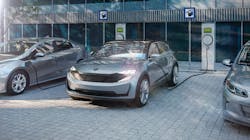The Electric Power Research Institute (EPRI) is exploring creative and efficient ways to store and deliver energy to enable a cleaner, more resilient and more sustainable electric grid. One technology with the potential to deliver grid and customer benefits is known as Vehicle-to-Grid (V2G).
Consider that approximately 85% to 90% of all vehicles are parked at any given time, whether in our driveways, parking garages, or on the street. By the end of this decade, electric vehicles (EVs) are expected to constitute a significantly greater portion of total vehicles. The International Energy Agency is projecting more than 130 million EVs will be on the road by 2030. If a large majority of vehicles are parked at any given time, and an increased percentage of those will soon be EVs, there will be a significant number of available EVs connected to the electric grid. With hundreds of thousands of vehicles in an energy market “plugged in” with available battery stored energy, this offers an opportunity for a low-cost energy storage solution using V2G capabilities that provide energy back to the grid when not being used for mobility.
V2G technologies enable EVs to transmit power to the energy system by managing bidirectional charging and discharging the of batteries from or to the grid. A recent EPRI study found that utilities and customers can derive substantial value from large-scale deployment of EVs equipped to send power to the grid in this way. Such technologies can potentially lower grid operational costs by reducing peak demand, shifting load to off-peak times, and providing ancillary service.
Many studies have documented grid benefits of managed or smart charging systems through which a utility can remotely control charging times or levels. By creating a smarter grid and EV charging, the utility can manage cooperatively with the EV when a vehicle charges and when it provides power to the grid. An effort is underway in California to explore the possibilities in the light-duty sector.
EPRI researchers developed models to calculate the potential value of V2G-capable vehicles to California’s distribution systems. If implemented at scale, V2G has the value that is two to three times the value obtainable through managed charging, even when the EV prioritizes the battery operation for mobility over its application to grid services over the life of the battery to ensure the batteries can last the life of the vehicle. As battery size on the EVs approaches 100 kWh and beyond, it is increasingly possible to set aside 10 to 15 percent of a V2G-equipped EV battery to power critical appliances in the home when needed; an approach that provides even greater value in conjunction with rooftop PV charging these batteries during the daytime. For reference, most integrated rooftop solar and energy storage installations have a stationary battery that is rated at about 10 kWh.
Based on EPRI research, V2G technologies in California have the potential to provide:
- $671 million in annual grid benefits, based on 3.3 million EVs in 2030, with half of those EVs V2G-enabled;
- $1 billion in annual grid benefits, given 5 million EVs in 2030; and
- If half of California’s 600,000 EVs today were V2G-enabled, they could provide $39 million in annual net value from peak shaving and ramping support.
As with many emerging technologies, there are barriers to realize its full value. For example, there are no uniform interconnection requirements for V2G-capable EVs to be treated as “generating resources” that provide power back to the grid. In addition, making V2G technology available at broader scale will require both a clarification of requirements and an energy market pathway to incentivize drivers for providing their EVs to perform grid-supporting functions. Lastly, stakeholders must weigh the potential grid benefits against the risk of battery degradation due to increased use. However, with increasing battery size and improving electrochemistry, this risk has significantly alleviated. To further mitigate this issue, in any practical implementation, the vehicle will need to actively constrain battery use for V2G application based on the battery state and customer preferences.
EVs are poised to deliver greater value as a grid resource benefiting utility customers and vehicle owners. EPRI continues to facilitate collaborative projects and research among utilities and automakers to identify and deliver the public benefits of V2G technologies enabling accelerated adoption.
About the Author
Sunil Chhaya
Electric Power Research Institute
